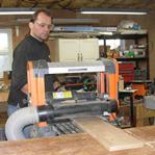St. Kilian chapel – Credence table – part 2
With the columns put together, I can now mill up all the rest of the column parts.
Starting with the base, I cut down some 8″ wide 6/4 oak to be long enough to make both pieces.
Then I joint the edges and plane them down to the correct thickness.
After the base blanks are cut, I make a 1″ thick board to cut the base caps from and a 3/4″ thick board to make the column caps with.
After they are milled straight and flat, I set up a stop block on my miter saw and cut them into little squares.
After a quick dry-fit to make sure that everything looks right, I take the bases to the router table to mill the 1/2″ chamfer around the top.
I switched the bit, after they were done, to the 3/4″ round-over bit, then radiused the top of the base caps.
Then I took everything over to the bench and started sanding…
With all the extra pieces done, it was time to get back to the columns.
I set up the 3/4″ dado blade and grabbed my large cross-cut sled, then set the blade height to 1/2″.
This groove was cut directly in the center of the columns to create a slot to hold the small shelf.
I did a test fit of the small shelf, just to make sure it fit right. Nice and snug, perfect fit.
Then I dropped the blade height down to 1/8″ high and cut the trim channel for all of the walnut trim.
Speaking of walnut trim, I need to make some more bull-nose trim. I grabbed a nice piece of walnut and milled it down to 3/4″ thick, then cut it into strips 1-5/8″ wide.
I applied a 3/8″ round-over to each of the four edges to create a full bull-nose on each side.
It is safer to create a double-wide piece, then cut it in half, rather than to try and a single bull-nose from a 3/4″ square piece.
After ripping all of the strips in half, I replaced the large cross-cut sled with the smaller one that has my trim cutting jig installed.
I cut the first piece from the long strip, then flip the piece around and cut the matching angle on the opposite side.
I made eight of these to check that my size was good.
Using quick-setting CA glue to glue the miters together.
I do four at a time to create half of the trim piece for each end.
While the glue is still tacky on the exposed areas, I sand the joints forcing sawdust into any exposed gaps, filling them in and smoothing them over.
So that the column has a tiny bit of room to expand and contract, I use a flexible adhesive on the inside of the trim and CA glue on the miters.
I press them together till they set. There is a small gap between the walnut and the oak column. Hopefully this will allow the column to expand slightly without putting stress on the walnut trim.
Then I sand the two joints to smooth and fill them as well.
The first column was trimmed successfully so I cranked out the rest of the trim pieces to do the other three.
About three or four hours later, those were done as well…
Just before putting it all together, I remembered to apply a 1/4″ radius to the top edge of the table top to match the arms of the chair.
Then it was time for a dry-fit.
I noticed that one thing was missing. I forgot to radius the corners of the top to match the arms.
I used a coin to trace the radius at each corner, then sanded the curve onto the corners with my belt/disc sander.
This was a little rough so I finessed the curve and blended the top radius in with my foam sanding blocks.
Now everything was ready for assembly, but it was getting late so I will save the rest for tomorrow.













































